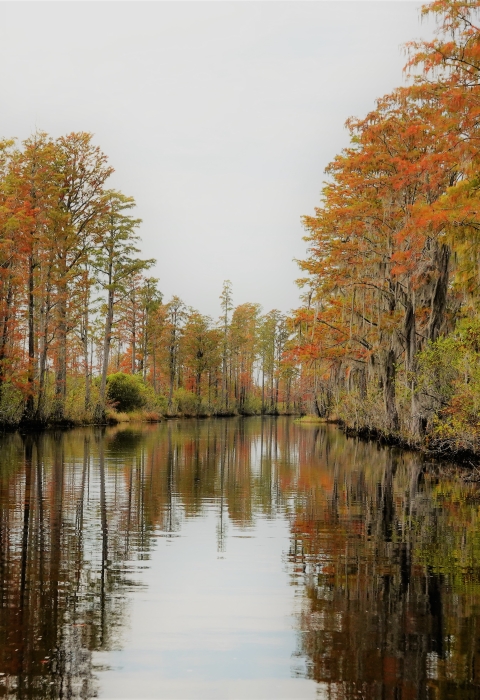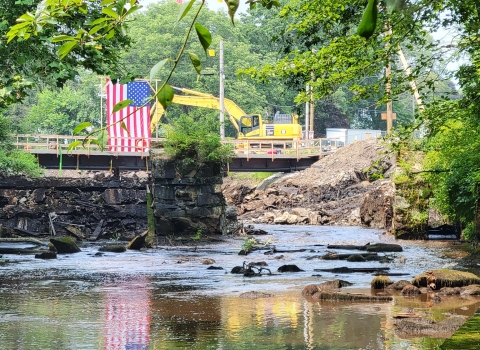Does the U.S. Fish and Wildlife Service oppose Twin Pines Mine?
The U.S. Fish and Wildlife Service opposes the proposed Twin Pines Minerals LLC, mining project and reclamation activities adjacent to the Okefenokee National Wildlife Refuge.
Based on independent evaluations, there is currently not enough information to properly evaluate the effects of withdrawing 1.44 million gallons of water per day from the Floridian aquifer.
The modeling and hydrogeologic characterization presented by the consultant for Twin Pines Minerals LLC is inadequate to assess this important question.
Mining expansion northward along Trail Ridge presents a real threat to the swamp’s ecosystems. The further north that mining expands up Trail Ridge, the closer it approaches the Okefenokee swamp. Trail Ridge acts as an earthen dam blocking the swamp from draining to the east. Mining Trail Ridge poses a risk to this dam, which is part of an ancient and delicate ecosystem.
Are there potential impacts on the refuge from the mine that the Service is concerned about?
The Service is concerned with mining-induced changes to surface and groundwater that could result in lowered groundwater levels in Okefenokee Swamp.
We believe reduced water availability will negatively impact habitat for federally listed and at-risk fish and wildlife species.
Changes to water levels could result in changes to fire regimes and reduce the capacity of the swamp to retain and capture carbon through drying of peat. This drying could, in turn, increase the threat of catastrophic fire and the release of additional carbon through burning peat.
Wildfires in and around the Okefenokee swamp occur on a regular basis. The increased wildland fire activity from increased drought would threaten millions of dollars of commercial timberland that immediately surround Okefenokee swamp.
Does the Service agree with Twin Pines and Georgia’s Environmental Protection Department’s conclusion that the mine will not harm the refuge? If not, why not?
The Service does not agree with the conclusion that the mine will not harm the refuge. Based on independent evaluation, there is currently not enough information to properly evaluate the effects of withdrawing 1.44 million gallons of water per day from the Floridian aquifer. Permitting mining nearby may lead to irreversible damage to the refuge, a National Natural Landmark National Natural Landmark
The National Natural Landmarks Program preserves sites illustrating the geological and ecological character of the United States. The program aims to enhance the scientific and educational value of the preserved sites, strengthen public appreciation of natural history and foster a greater concern for the conservation of the nation’s natural heritage. The program was established in 1962 by administrative action under the authority of the Historic Sites Act of 1935. The first National Natural Landmarks were designated in 1963. Today, there are more than 600 National Natural Landmarks in 48 states, American Samoa, Guam, Puerto Rico and the U.S. Virgin Islands.
Learn more about National Natural Landmark as designated by the Secretary of the Interior and an internationally recognized RAMSAR Wetland of International Importance.
As we consider actions that could alter the water levels and ecosystem balance of the Okefenokee Swamp, we need better information before taking a risk that could impact such an important national treasure.
We are urging the State of Georgia to refrain from issuing any final permits until our concerns are adequately addressed and additional data on the Floridan aquifer below the swamp can be obtained.
Is the Service concerned that the mining could expand beyond Twin Pines’ 582-acre demonstration mine in the future?
Yes. While the proposed mine is 2.9 miles away from the edge of the swamp, if Twin Pines Minerals expand their mining activities northward into the remaining acres of their property as originally planned, the mine footprint will be within 400 feet of the swamp. As the ridge acts as an earthen dam blocking the swamp from draining to the east, this potential expansion northward along Trail Ridge presents a real threat to the swamp’s water levels and ecosystem balance.
Is the Service concerned that the mine could harm the refuge’s bid for World Heritage listing?
Yes. Okefenokee National Wildlife Refuge has exceptional ecological values, which are considered for this designation. Location of a mine next to the refuge could reduce the refuge’s likelihood of being inscribed as a World Heritage Site.
What is the significance of the refuge from an ecological and climate change climate change
Climate change includes both global warming driven by human-induced emissions of greenhouse gases and the resulting large-scale shifts in weather patterns. Though there have been previous periods of climatic change, since the mid-20th century humans have had an unprecedented impact on Earth's climate system and caused change on a global scale.
Learn more about climate change perspective?
The swamp has been designated as a National Natural Landmark by the Secretary of the Interior, and as a Wetland of International Importance by the Ramsar Convention on Wetlands.
The name Okefenokee is derived from an ancient Creek/Muscogee word, Oh-guah-fen-ogah, which means “trembling waters in a low place.” The ecology of the Okefenokee Swamp sustained the lives of ancient peoples who depended on it for food, shelter, and community. And centuries later, this is still the case for people who call the Okefenokee region home.
The astounding thing about the Okefenokee is that the hydrology of the swamp is still intact, meaning that the ecosystem that you see there today is essentially the same as it would have been when the first people beheld its dark, flowing waters. The geological feature that allowed the swamp to form in the first place, and still allows it to exist, is the ancient barrier island known as Trail Ridge, which supports the integrity of the Okefenokee swamp. Trail Ridge was likely used as a travel corridor by the Muscogee Creek Nation’s ancestors, and burial mounds have been documented along portions of the feature.
The Okefenokee is important because it is a gigantic carbon storehouse. Because the waters of the Okefenokee are shallow and warm and therefore have low oxygen, vegetation that falls into the water does not completely decompose. That vegetation then piles on top of itself and forms thick mats of peat that store amazing amounts of carbon. It has been estimated that there is as much as 120,000,000 metric tons of carbon. That’s more than all the carbon stored in the plants growing in the Okefenokee!
Extensive peat beds store notable amounts of carbon and preserves the historic record of regional terrestrial and freshwater ecosystems over the past several millennia. With less than 1% of the refuge’s peatland disturbed by man, it is the largest remaining intact planar peat bed on the North American Coastal Plain and within the Northern Hemisphere’s subtropical zone.
In addition, the refuge’s uplands represent the southern yellow pine savannas that once were the most extensive “forest” type in the United States. With only 4% of the original range of longleaf pine remaining today, restoration efforts on the refuge contribute to the longleaf pine initiative across the Southeast.
The Okefenokee Swamp is the largest precipitation-based freshwater wetland ecosystem in the United States and one of the world’s largest naturally driven freshwater ecosystems in the highly populated temperate/subtropical climate zone.
The refuge represents the 36th recognized global biodiversity hotspot, the North American Coastal Plain, by providing quality freshwater wetland and upland habitats that support 14% of the flora species and 29% of the fauna species found in this hotspot.
North American Coastal Plain has a significant number of endemics, and many are represented within Okefenokee National Wildlife Refuge. The refuge is world renowned for its herpetofauna and supports 25% of the reptile species and 32% of the amphibian species that are considered endemic to the North American Coastal Plain. Twelve percent of the endemic bird species utilize Okefenokee National Wildlife Refuge including the endangered Red-cockaded Woodpecker and threatened Wood Stork. Nine percent of the endemic fish species prosper within the refuge’s acidic, tannin waters. The expanse of Okefenokee National Wildlife Refuge also supports a large population of Florida black bears and in the past was considered for the re-introduction of Florida panthers, two large mammal species endemic to the North American Coastal Plain.
More than 850 plant species have been identified on the refuge, which includes 18 carnivorous plant species, with the giant Okefenokee pitcher plant (Sarracenia minor var. okefenokeensis) endemic to the Okefenokee Swamp. There is also numerous 500+ year old pond cypress trees scattered over approximately 2,000 acres of the swamp.
The refuge is located within the Southeast United States Conifer Savannas Terrestrial ecoregion where only 1-4% of the habitat remains unaltered. Floral species richness within this habitat is “unparalleled outside of [the] tropics,” especially regarding rare, endemic, and carnivorous species.
Where can more information be found on the Twin Pines Mining Project and the permit process?
The decision to issue final permits for Twin Pines Mine is with the Georgia Environmental Protection Division (GAEPD).
https://epd.georgia.gov/twin-pines


